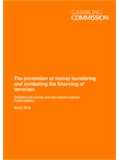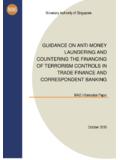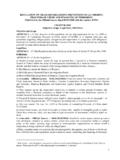Transcription of Basel Committee on Banking Supervision
1 Basel Committee on Banking Supervision Guidelines Sound management of risks related to money laundering and financing of terrorism This document includes final revisions to Annex II - Correspondent Banking and Annex IV -General Guide to Account Opening issued for consultation in November 2016). June 2017 This publication is available on the BIS website ( ). Bank for International Settlements 2017. All rights reserved. Brief excerpts may be reproduced or translated provided the source is stated. ISBN 978-92-9259-053-6 (online) Sound management of risks related to money laundering and financing of terrorism Contents Sound management of risks related to money laundering and financing of terrorism .
2 1 I. Introduction .. 1 II. Essential elements of sound ML/FT risk management .. 3 1. Assessment, understanding, management and mitigation of risks .. 4 (a) Assessment and understanding of risks .. 4 (b) Proper governance arrangements .. 4 (c) The three lines of defence .. 4 (d) Adequate transaction monitoring system .. 6 2. Customer acceptance policy .. 7 3. Customer and beneficial owner identification, verification and risk profiling .. 7 4. Ongoing monitoring .. 10 5. Management of information .. 11 (a) Record-keeping .. 11 (b) Updating of information .. 11 (c) Supplying information to the supervisors .. 11 6. Reporting of suspicious transactions and asset freezing.
3 11 (a) Reporting of suspicious transactions .. 11 (b) Asset freezing .. 12 III. AML/CFT in a group-wide and cross-border context .. 12 1. Global process for managing customer risks .. 13 2. Risk assessment and management .. 13 3. Consolidated AML/CFT policies and procedures .. 14 4. Group-wide information-sharing .. 15 5. Mixed financial groups .. 15 IV. The role of supervisors .. 16 Annex 1: Using another bank, financial institution or third party to perform customer due diligence .. 19 Annex 2: Correspondent Banking .. 23 Annex 3: List of relevant FATF recommendations .. 32 Annex 4: General guide to account opening .. 33 Sound management of risks related to money laundering and financing of terrorism 1 Sound management of risks related to money laundering and financing of terrorism I.
4 Introduction 1. Being aware of the risks incurred by banks of being used, intentionally or unintentionally, for criminal activities, the Basel Committee on Banking Supervision is issuing these guidelines to describe how banks should include money laundering (ML) and financing of terrorism (FT) risks within their overall risk management. 2. The Committee has a long-standing commitment to promote the implementation of sound Anti- money laundering and Countering financing of terrorism (AML/CFT) policies and procedures that are critical in protecting the safety and soundness of banks and the integrity of the international financial system.
5 Following an initial statement in 1988,1 it has published several documents in support of this commitment. In September 2012, the Committee reaffirmed its stance by publishing the revised version of the Core principles for effective Banking Supervision , in which a dedicated principle (BCP 29) deals with the abuse of financial services. 3. The Committee supports the adoption of the standards issued by the Financial Action Task Force (FATF).2 In February 2012, the FATF released a revised version of the International Standards on Combating money laundering and the financing of terrorism and Proliferation (the FATF standards), to which the Committee provided In March 2013, the FATF also issued Financial Inclusion Guidance, which has also been considered by the Committee in drafting these guidelines.
6 The Committee s intention in issuing this paper is to support national implementation of the FATF standards by exploring complementary areas and leveraging the expertise of both organisations. These guidelines embody both the FATF standards and the Basel Core Principles for banks operating across borders and fits into the overall framework of Banking Supervision . Therefore, these guidelines are intended to be consistent with and to supplement the goals and objectives of the FATF standards, and in no way should they be interpreted as modifying the FATF standards, either by strengthening or weakening them. 4. In some instances, the Committee has included cross-references to FATF standards in this document in order to assist banks in complying with national requirements based on the implementation of those standards.
7 However, as the Committee s intention is not to simply duplicate the existing FATF standards, cross-references are not included as a matter of routine. 5. The Committee 's commitment to combating money laundering and the financing of terrorism is fully aligned with its mandate to strengthen the regulation, Supervision and practices of banks worldwide with the purpose of enhancing financial stability .4 Sound ML/FT risk management has particular relevance 1 See BCBS, Prevention of criminal use of the Banking system for the purpose of money - laundering , December 1988, accessible at 2 The FATF is an intergovernmental body that develops international standards and promotes policies to protect the global financial system against money laundering , terrorist financing and the financing of proliferation of weapons of mass destruction.
8 The FATF defines money laundering as the processing of criminal proceeds in order to disguise their illegal origin. The FATF works in close cooperation with other entities involved in this area, and in particular FATF associate members and observers. The Committee has observer status within the FATF. 3 Annex 3 contains an excerpt of the most relevant FATF Recommendations that banks and supervisors should comply with when implementing their AML/CFT measures. This is not exhaustive and other FATF Recommendations, including the Interpretive Notes, may be relevant. The full document is accessible at 4 See Basel Committee on Banking Supervision , Charter, January 2013, accessible at 2 Sound management of risks related to money laundering and financing of terrorism to the overall safety and soundness of banks and of the Banking system, the primary objective for Banking Supervision , in that: it helps protect the reputation of both banks and national Banking systems by preventing and deterring the use of banks to launder illicit proceeds or to raise or move funds in support of terrorism .
9 And it preserves the integrity of the international financial system as well as the work of governments in addressing corruption and in combating the financing of terrorism . 6 The inadequacy or absence of sound ML/FT risk management exposes banks to serious risks, especially reputational, operational, compliance and concentration risks. Recent developments, including robust enforcement actions taken by regulators and the corresponding direct and indirect costs incurred by banks due to their lack of diligence in applying appropriate risk management policies, procedures and controls, have highlighted those risks. These costs and damage could probably have been avoided had the banks maintained effective risk-based AML/CFT policies and procedures.
10 7. It is worth noting that all these risks are interrelated. However, in addition to incurring fines and sanctions by regulators, any one of them could result in significant financial costs to banks (eg through the termination of wholesale funding and facilities, claims against the bank, investigation costs, asset seizures and freezes, and loan losses), as well as the diversion of limited and valuable management time and operational resources to resolve problems. 8. Consequently, this paper should be read in conjunction with a number of related Committee papers, including the following: Core principles for effective Banking Supervision , September 20125 The internal audit function in banks, June 20126 Principles for the sound management of operational risk, June 20117 Principles for enhancing corporate governance, October 20108 Due diligence and transparency regarding cover payment messages related to cross-border wire transfers, May 20099 Compliance and the compliance function in banks, April 200510 9.















